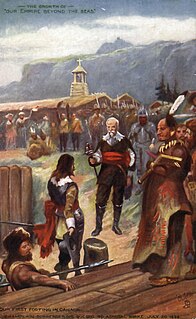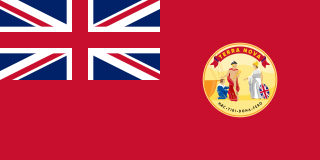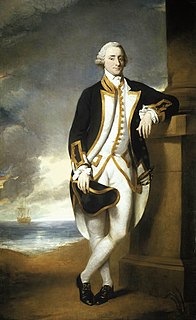Peter Easton was a pirate in the early 17th century who operated along the Newfoundland coastline between Harbour Grace and Ferryland from 1611 to 1614. Perhaps one of the most successful of all pirates. He controlled such seapower that no sovereign or state could afford to ignore him and he was never overtaken or captured by any fleet commissioned to hunt him down. However, he is not as well known as some of the pirates from the late 17th and early 18th centuries.

Sir David Kirke was an adventurer, colonizer and governor for the king of England. He is best known for his successful capture of New France in 1629 during the Thirty Years' War and his subsequent governorship of lands in Newfoundland. A favourite of Charles I of England, the fall of the Crown during the English Civil War led to Kirke's downfall. It is believed he died in prison.

Thomas Graves, 1st Baron Graves KB was a British Admiral and colonial official.

Newfoundland was a British dominion from 1907 to 1949. The dominion, situated in northeastern North America along the Atlantic coast, comprised the island of Newfoundland as well as Labrador on the continental mainland. Before attaining dominion status, Newfoundland was a British colony, self-governing from 1855.

Admiral Sir Charles Hardy was a Royal Navy officer and politician who sat in the House of Commons between 1764 and 1780. He served as colonial governor of New York from 1755 to 1757.

Grand Bank, Newfoundland and Labrador, Canada or 'Grand Banc' as the first French settlers pronounced it, is a small rural town with a population of 2,580. It is located on the southern tip or "toe" of the Burin Peninsula, 360 km from the province's capital of St. John's.

Admiral Sir Hugh Palliser, 1st Baronet was a Royal Navy officer. As captain of the 60-gun HMS Eagle he engaged and defeated the French 50-gun Duc d'Aquitain off Ushant in May 1757 during the Seven Years' War. He went on to serve as Commodore Governor of Newfoundland, then Comptroller of the Navy and then First Naval Lord. During the American Revolutionary War he came into a famous dispute with Augustus Keppel over his conduct as third-in-command of the Channel Fleet at the inconclusive Battle of Ushant in July 1778; the dispute led to Palliser being court-martialled, although he was subsequently acquitted. In retirement Palliser became Governor of Greenwich Hospital.

USS Ericsson (DD-440), a Gleaves-class destroyer, was the third ship of the United States Navy to be named after John Ericsson, who is best known for devising and building the Civil War ironclad USS Monitor.

Harbour Grace is a town in Conception Bay on the Avalon Peninsula in the province of Newfoundland and Labrador, Canada. With roots dating back to the 16th century, it is one of the oldest towns in North America.
Edward Falkingham was an officer in the Royal Navy. He served for a time as Governor of Newfoundland and Comptroller of the Navy.

Sir Charles Henry Darling was a British colonial governor.
The first brief European contact with Newfoundland and Labrador came about 1000 AD when the Vikings briefly settled in L'Anse aux Meadows. Around 1500, European explorers and fishermen from England, Portugal, Netherlands, France, and Spain began exploration. Fishing expeditions came seasonally; the first small permanent settlements appeared around 1630. Catholic-Protestant religious tensions were high but mellowed after 1860. The British colony voted against joining Canada in 1869 and became an independent dominion in the early 20th century. Fishing was always the dominant industry, but the economy collapsed in the Great Depression of the 1930s and the people voluntarily relinquished their independence to become a British colony again. Prosperity and self-confidence returned during the Second World War, and after intense debate the people voted to join Canada in 1949.

Bay Bulls is a small fishing town in the province of Newfoundland and Labrador, Canada.
USS Albatross (AM-71) was an Albatross-class minesweeper of the United States Navy during World War II.

The Newfoundland expedition was a naval raiding expedition led by English Captain John Leake between August and October 1702 that targeted French colonial settlements on the North Atlantic island of Newfoundland and its satellite Saint Pierre. The expedition occurred in the early days of Queen Anne's War, as the North American theater of the War of the Spanish Succession is sometimes known.

The Newfoundland expedition was a series of fleet manoeuvres and amphibious landings in the coasts of Newfoundland, Labrador and Saint Pierre and Miquelon carried out by the combined French and Spanish fleets during the French Revolutionary Wars. This expedition, composed of seven ships of the line and three frigates under the orders of Rear-Admiral Richery sailed from Cadiz in August 1796 accompanied by a much stronger Spanish squadron, commanded by General Solano, which had the aim of escorting it to the coast of Newfoundland.

Newfoundland Colony was the name for an English and later British colony established in 1610 on the island of the same name off the Atlantic coast of Canada, in what is now the Canadian province of Newfoundland and Labrador. This followed decades of sporadic English settlement on the island, at first seasonal rather than permanent. It was made a Crown colony in 1854 and a Dominion of the British Empire in 1907. The economy collapsed during the Great Depression and Newfoundland relinquished its dominion status, becoming once again a crown colony, governed by appointees from the colonial office in London. American forces occupied much of the colony in World War II, and prosperity returned. In 1949 the colony voted to join Canada as the Province of Newfoundland, but in 2001 its name was officially changed to Newfoundland and Labrador.
The Newfoundland Station was a formation or command of, first, the Kingdom of Great Britain and, then, of the United Kingdom's Royal Navy. Its official headquarters varied between Portsmouth or Plymouth in England where a squadron of ships would set sail annually each year to protect convoys and the British fishing fleet operating in waters off the Newfoundland coast and would remain for period of approximately six months based at St. John's Harbour. In 1818 the station became a permanent posting headquartered at St John's. It existed from 1729 to 1825.
The Battle of the Levant Convoy was a naval engagement of the French Revolutionary Wars fought on 7 October 1795. During the battle, a powerful French squadron surprised a valuable British convoy from the Levant off Cape St Vincent on the coast of Portugal. The convoy was weakly defended, and although the small escort squadron tried to drive the French back, they were outmatched. In the ensuing action one of the British ships of the line and almost the entire convoy was overrun and captured. The French commander, Commodore Joseph de Richery, then retired to the neutral Spanish port of Cádiz, where he came under blockade.













